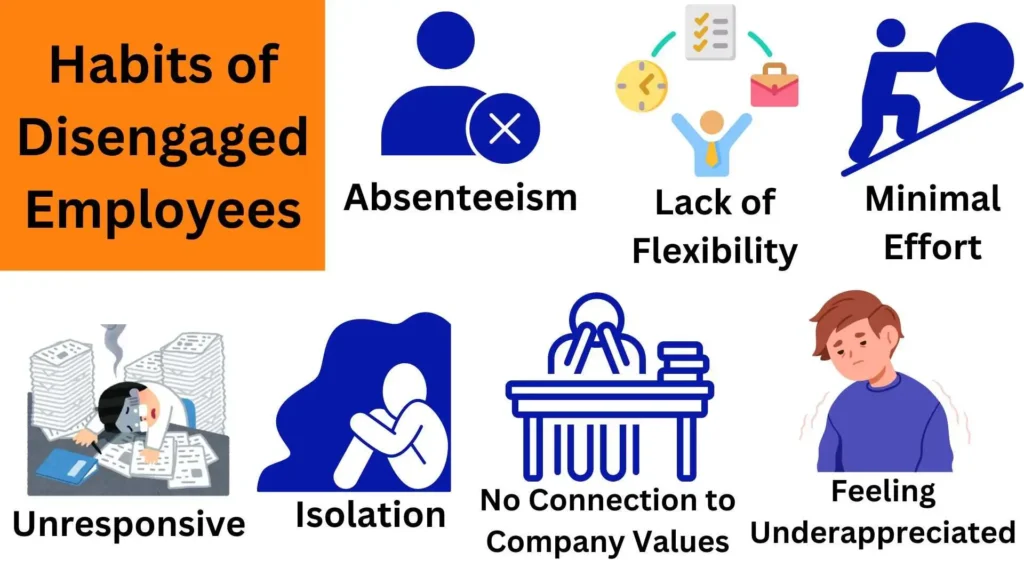It’s Monday again. Your alarm is buzzing, and you want to sleep more. You may be wondering. Oh, man! Not again. At this time, you need more motivation and dedication to go to your workplace.
This kind of employee disengagement is a concerning trend in workplaces. Let’s not make it one of the 7 habits of highly disengaged employees.
The blog explores behaviors of disengaged employees and provides a detailed insight into signs of employee disengagement.
Table of Contents
Disengaged Employees
Disengaged employees are individuals within an organization who lack motivation, commitment, and enthusiasm for their work. They may exhibit low productivity, absenteeism, lack of initiative, and minimal interaction with colleagues.
Disengaged employees need more dedication and enthusiasm to work. They complete their tasks but do not put in additional effort to improve productivity.
Engaged vs. Disengaged employees
Before discussing the habits of highly disengaged employees, you need to understand engaged vs. disengaged employees.
The table below compares engaged and disengaged employees based on their motivation and willingness to cooperate in the workplace.
| ENGAGED EMPLOYEES | DISENGAGED EMPLOYEES |
|---|---|
| Fully Motivated | Lack of motivation and excitement |
| Takes the workplace as an opportunity | Takes workplace as an obligation |
| Openly share opinions | Socially withdrawn from the team |
| Willing to go beyond the edge | Reluctant to put in extra work |
| Proactive and resourceful | Uninspired and demotivated |
Signs of Employee Disengagement
How can we recognize disengaged employees? Some signs show that a person is disengaged at work.
Before discussing the habits of highly disengaged employees, let’s examine these signs of employee disengagement.
I. Productivity Decline or Low-Quality Work
Due to a lack of motivation, disengaged employees start producing low-quality work. They don’t put in maximum effort and begin having trouble with deadlines. This is a very prominent sign of employee disengagement, which can cause significant hurdles in the long term.
II. Negative Attitude
It is commonly observed that some employees that are disengaged start exhibiting a negative attitude. This becomes evident when they start criticizing their coworkers, become insecure about the excellent performance of other employees, and start complaining a lot.
III. Withdrawal from Collaborating Activities
Partial or complete withdrawal from collaborating activities is a sign of employee disengagement. Employees isolate themselves and feel reluctant to collaborate with other coworkers in a team. If you observe this hesitancy to collaborate with your fellow employees, address them about disengagement before this becomes their habit.
IV. Taking Breaks from Routine
You may observe your coworker who was previously well dressed and active to be oddly dressed and less interested. Also, an employee who was confident, vocal, and social at one time may start becoming isolated and non-interactive. These small breaks from routine also indicate disengagement.
V. Lack of Enthusiasm and Initiative
Disengaged employees seem to not give their best to the tasks assigned to them; they do not excel in their roles. They are hesitant to suggest some new ideas and innovative techniques. They appear to be less dedicated and less enthusiastic about anything they are instructed to do.
7 Habits of Highly Disengaged Employees
You might experience some discontent with your work or may feel demotivated to complete your tasks. After understanding the signs, you likely know what characterizes disengaged employees.
Now, you might wonder about the daily habits contributing to this disengagement. Don’t worry; let’s explore 7 habits highly disengaged employees.

1. Absenteeism
Due to less dedication to their work, disengaged employees start taking days off work other than the holidays allocated to them because they feel uninterested and tend to avoid coming to work.
It is one of the behaviors of highly disengaged employees who take long lunches and extra breaks throughout the day. They begin practicing this every day, and over time, it becomes their habit.
When asked about their absenteeism, they provide irrelevant reasons and indicate they are detached from their team and organization.
2. Lack of Flexibility
Flexibility is required in every walk of life, especially professional life. It is also one of the habits of mind.
Having less room for flexibility costs a lot. Disengaging employees is ineffective for both employees and organizations.
Sometimes, meetings get rescheduled, or some tasks require overtime. Engaged employees are much more flexible in adapting to these changes.
In contrast, disengaged employees tend to be rigid and lack flexibility. They are not willing to attend the rescheduled meetings and don’t put in extra hours for challenging tasks.
3. Minimal Effort
It is a defining behavior of disengaged employees. Instead of going the extra mile, they focus on completing assigned work without putting some additional effort into these tasks.
Since they don’t feel excited and enthusiastic about their work, they merely do enough to meet basic requirements.
4. Unresponsiveness
Disengaged employees are unresponsive, especially when communicating with coworkers. It is one of the prime habits of highly disengaged employees.
They may delay responding to Emails, texts, and online meetings, which affect team dynamics.
Additionally, they tend to remain quiet during real-time meetings, refraining from sharing ideas or asking questions. When asked for feedback, they either provide vague responses or respond poorly.
5. Isolation
Disengaged employees are always mindful of the time, watching the clock after every minute. They wonder when it all is over and when they can go home. This distraction shifts their focus away from engaging with other employees and collaborating, ultimately leading to isolation.
Due to minimal interaction with other employees, they limit communication and resist socializing.
Additionally, their low energy levels are caused by constant fatigue, lack of enthusiasm, and disinterest, which leads them to isolate themselves both physically and emotionally.
In this way, disengaged employees prefer isolation from group tasks and team activities. Ultimately, this declines their productivity, which is one of the habits of high performance discussed by Brendon Burchard.
6. Lack of Connection to Company Values
Lack of connection to company values is also one of the common habitual patterns of disengaged employees. It is expected that when a person’s beliefs and values do not match the organization’s stated principles and administration, disengagement often seeps in.
Disengaged employees hold conflicting beliefs that do not align with the organization’s mission, resulting in a lack of commitment and enthusiasm.
Also, the toxic behavior of disengaged employees diminishes trust in the company’s vision and beliefs, leading them to operate on autopilot.
7. Feeling Underappreciated
The habit of feeling underappreciated diminishes the motivation of disengaged employees, significantly impacting their performance.
They are reluctant to share their point of view and opinions, often feeling afraid and lacking confidence. This reluctance stems from a sense of being undervalued. They tend to underestimate their abilities and aptitudes.
Constantly feeling underappreciated lowers their motivation, causing them to stop putting in maximum effort and settle for the bare minimum.
This habit becomes a source of decline in performance and work habits.
How to Deal with Disengaged Employees?
After recognizing the signs and habits of highly disengaged employees, the employers or managers of organizations should take some constructive steps to engage them and ensure productivity.
Let’s have a glance at practical steps to deal with disengaged employees in the workplace:
I. Crafting Policies for Employee Engagement
You must formulate clear policies to promote employees’ well-being and performance levels and prevent disengagement from becoming a habit.
Continuously recap, review, and update existing strategies considering changing trends and employee needs.
II. Provide Feedback
Feedback is one of the good habits for improving lifestyle and also a really effective method for dealing with disengaged employees, as feedback from others is a great way to analyze self-progress.
So, provide constructive feedback to them. This will help them analyze their strengths and weaknesses and enhance their productivity.
III. Recognize and Reward
Recognizing and rewarding yourself or others is very effective as it boosts confidence and motivation. Before disengagement becomes a habit, your employees should acknowledge their efforts publically or privately.
Establish a monetary or non-monetary reward system to boost their morale and appreciate their contributions.
IV. Encourage Open Communication
To prevent the habit of isolation in disengaged employees, create an environment where employees feel comfortable sharing their opinions and openly communicating with coworkers.
Encourage regular team meetings, suggestion boxes, and open-door policies to facilitate transparent communication.
V. Learn from Firms with High Employee Engagement
Continuously analyze and study the policies of firms excelling in employee engagement. What do they implement that your firm lacks? Understand their culture and strategies to adapt and improve your employee engagement initiatives.
How Does Employee Disengagement Affect Attrition?
Let’s discuss why we examined 7 habits of highly disengaged employees. These habits cause employees to become disengaged and contribute significantly to the company’s attrition rate.
The attrition rate is the quantifiable rate at which employees leave an organization, leading to a decline in productivity and overall progress.
According to the Gallup State of Global Workplace:2023 Report, 51% of currently employed workers seek or actively seek a new job. This means they are likely to leave their jobs once they get a good opportunity. This report leads us to examine the critical importance of the impacts of disengagement in mitigating turnover and attrition.
After gaining insight into behaviors of highly disengaged employees, it is essential to discuss some impacts of disengagement on the company’s attrition rate.
I. Increased Turnover
Disengaged employees are likely to quit voluntarily. High turnover, the number of employees leaving an organization in a specific period, affects team dynamics and productivity and increases recruitment costs.
II. Cost Implications due to turnover
Due to high turnover, resources are affected and drained, sometimes reaching the bottom line. Recruiting, onboarding, and training new employees incur expenses that impact the organization financially.
III. Decreased Productivity
Due to a lack of enthusiasm, disengaged employees need to go above and beyond and put in minimal effort, which can lead to hurdles in smooth organizational functioning and overall team output.
IV. Loss of Expertise
When fully skilled employees become disengaged, their knowledge and expertise are lost. New employees need a long time to reach that level of proficiency, posing challenges for the firm.
V. Loss of Morale in other Coworkers
One behavior of disengaged employees is exhibiting a negative attitude. This toxic attitude affects their coworkers and teammates, affecting team cohesion and job satisfaction.
How do Different Organizations Engage Disengaged Employees?
After learning some behaviors of disengaged employees and ways to engage them, let’s examine real stories of how organizations engaged their employees and saved millions.
- Discovery Communications, the mass media platform in America, had the challenge to support its ability to attract and retain top creative content within the competitive media industry. In addition, the company also needed help reaching out to its young workforce. To engage its young workforce, the company implemented Reward Getaway, a platform to extend employee’s paychecks and give them discounts. It was implemented within 10 locations in the U.S. Discovery Communication saw an increase in engagement by about 50% within the first six months.
- Krispy Kreme Doughnuts, an American multinational doughnut house and coffeehouse chain, created a centralized employee engagement platform named The KK Mixer to encourage communication among employees and increase engagement. The platform included rewards and recognitions, employee discounts, and some onboarding materials. The company observed that 73% of the workforce registered on the platform within the first seven months of implementation.
Conclusion
Employee disengagement is a growing concern in the workplace today. You need to know the 7 habits of highly disengaged employees to reduce the disengagement rate. These employees lack motivation and fail to contribute to the organization’s success, leading to a decline in performance. In contrast, engaged employees are proactive and resourceful, driving productivity. Signs of disengagement include a negative attitude and avoidance of team activities. Employers must implement policies to foster open communication and engagement to address disengagement and mitigate its impact on turnover and costs.
FAQs
How do disengaged employees affect workplace productivity, and what can be done to address that issue?
Those employees that are disengaged significantly reduce workplace productivity by performing below their potential. They take longer to finish tasks, consuming the company’s time and resources to produce low-quality work, which reduces efficiency. To address this, organizations should focus on improving communications, recognizing efforts, and providing growth opportunities.
Why are employees disengaged in the workplace?
Employees may be disengaged in a workplace for several reasons, such as heavy workloads, lack of appreciation, changes in leadership, personnel issues, misalignment with the company’s goals, lack of constructive feedback, and some market challenges. These are the root causes, but there may also be other reasons.
Who are actively disengaged employees?
While employees that are disengaged may be squandering their time while working and putting in minimal effort, actively disengaged employees are not only demotivated but also hold grudges and criticize their coworkers. They undermine an organization’s success, misuse its resources, and become a menace to employers.




